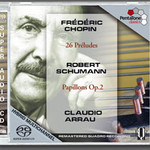
Complete Preludes (with Schumann-Papillons Op.2)
 $40.00
Out of Stock
$40.00
Out of Stock6+ weeks add to cart
CHOPIN
Complete Preludes (with Schumann-Papillons Op.2)
Claudio Arrau (piano)
[ Pentatone SACD / SACD ]
Release Date: Thursday 1 February 2007
This item is currently out of stock. It may take 6 or more weeks to obtain from when you place your order as this is a specialist product.
In just 40 minutes, the cosmos was created. To be sure, here we are talking solely about a pianistic cosmos: yet it is one that still, more than 170 years after its creation, remains breath-taking and arouses many diverse emotions, including unlimited admiration. The oeuvre in question is Frédéric Chopin's Preludes, Op. 28.
Hybrid/SACD - playable on any compact disc player
DSD recorded
In just 40 minutes, the cosmos was created. To be sure, here we are talking solely about a pianistic cosmos: yet it is one that still, more than 170 years after its creation, remains breath-taking and arouses many diverse emotions, including unlimited admiration. The oeuvre in question is Frédéric Chopin's Preludes, Op. 28. He wrote these 24 pianistic miniatures between 1836 and 1839, modelling them on the Preludes by Johann Sebastian Bach. However, he did not retain their "prologue-type" character: on the contrary, the variety of the works is more an indication of a secondary meaning of this term, i.e. fantasizing.
Among the greatest composers of the 19th century, Chopin is probably the only one to write more or less exclusively for "his" instrument, the piano. During a period of some 20 years, he composed almost 200 solo works. Not a huge output, compared to other extremely prolific composers of the day (whose names and works have now justifiably been forgotten). Chopin polished away at his compositions, until each one was defined by its own unmistakable personality. In order to classify the special distinctive features of his sound, one should probably not only emphasize the international character of his particular piano style, but also - and especially - point out the various compositional stages through which he went in his diverse roles of improviser, pianist, piano teacher and composer. Together, these blended into a highly potent mixture. German musicologists have generally tended to categorize Chopin rashly as a "salon composer", and thus make it impossible to view his music without prejudice. However, although Chopin most certainly encountered audiences for his music in the salon, the quality of his works undoubtedly soars far above that environment. Thus the "Chopineske" is the successful synthesis of a musical world view, which combines the operatic sweetness of Bellini, the calculated effect of Rossini, the contrapuntal gravity of Bach, as well as the harmony of Wagner in a jaunty, daring and calculating fashion.
The Preludes Op. 28 are monothematic and the nuclei of their motifs frequently comprise only one bar (at times, in fact, of only part of a bar), from which the works are then developed. The order of the 24 Preludes was determined (at a later date) according to the quint circle and the related minor keys. This brings up the question, especially for interpreters, of whether or not this is a cycle. Many pianists consciously select individual pieces from the opus: however, they tend to overlook the fact that this entire opus of Don Quichote-type works is dominated by an all-encompassing sense of drama, thanks to its contrast and expression. The pieces alternate continuously between triumph and despair, brilliance and darkness, excitement and composure.
The Prelude Op. 45, dating from 1841, is light years away from Op. 28 as regards style of composition. It is an "overcast" and poetic masterpiece, a bitter-sweet anticipation of the late Intermezzi by Brahms, interrupted by agonizing and tormenting transitions, a kaleidoscopic cadenza, and a coda of well-nigh operatic drama and declamation.
Robert Schumann wrote his Papillons, Op. 2 between 1829 and 1832. The cycle consists of 12 concise fantasy images, based on notes from his study books, in which he jotted down his musical ideas. The aphoristic Schmetterlinge (= butterflies) received an additional cachet thanks to the literary association with Jean Paul's Die Flegeljahren (= the years of adolescence). The two final chapters of the novel are entitled "Larven-Tanz" (= dance of the masks) and "Brief - Nachtwandler - Traum" (= letter - sleepwalker - dream). Here, Schumann demonstrates to the listener his "new approach to the variation form": thus he presents the individual miniatures (dance, ballroom, masks) as strongly contrasting, yet derives both motif and theme from a common source. The thematic material of the waltz in No. 1 determines the course of the remainder of the work, in which Schumann varies all elements and levels of the music, and as such subjects the character and development of the moods to a permanent transformation.
Tracks:
Chopin:
24 Preludes Op. 28
Prelude No.25 in C sharp minor, Op. 45
Prelude No.26 in A flat, Op. posth.
Schumann:
Papillons Op.2

